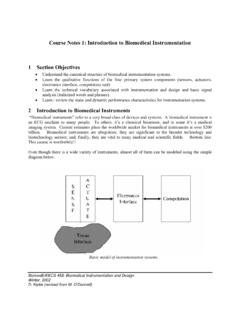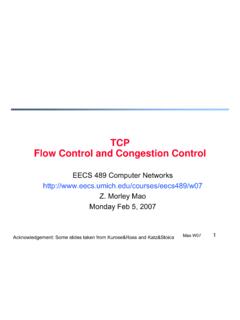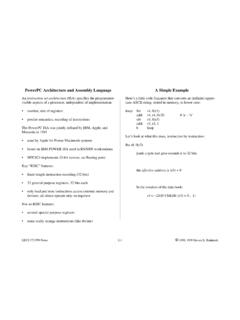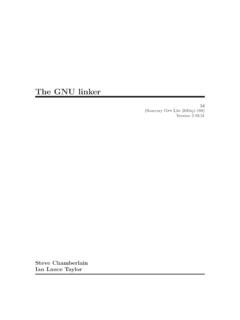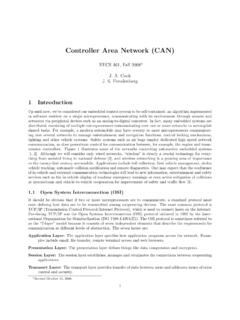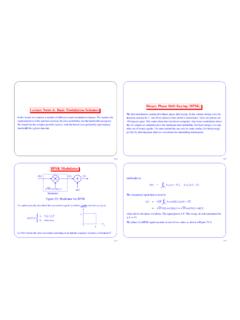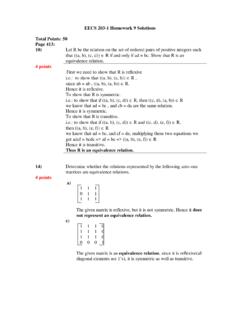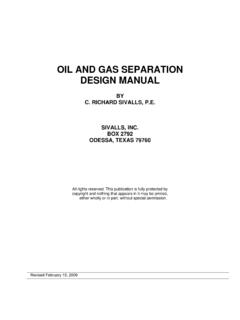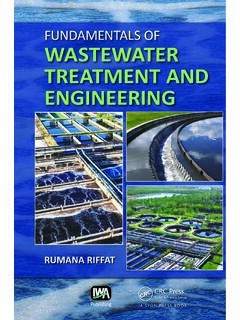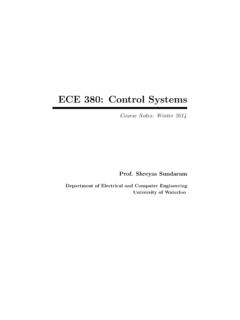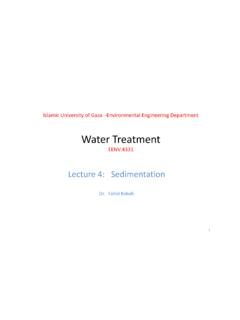Transcription of Introduction to Control Theory And Its Application to ...
1 Introduction to Control TheoryAnd Its Application to Computing SystemsTarek Abdelzaher1, Yixin Diao2, Joseph L. Hellerstein3,Chenyang Lu4, and Xiaoyun Zhu5 AbstractFeedback Control is central to managing computing systems and datanetworks. Unfortunately, computing practitioners typically approach the design offeedback Control in an ad hoc manner. Control Theory provides a systematic ap-proach to designing feedback loops that are stable in that they avoid wild oscil-lations, accurate in that they achieve objectives such as target response times forservice level management, and settle quickly to their steady state values. This pa-per provides an Introduction to Control Theory for computing practitioners with anemphasis on applications in the areas of database systems, real-time systems, virtu-alized servers, and power IntroductionFeedback Control is central to managing computing systems and networks.
2 For ex-ample, feedback (or closed loop systems) is employed to achieve response time ob-jectives by taking resource actions such as adjusting scheduling priorities, memoryallocations, and network bandwidth allocations. Unfortunately, computing practi-tioners typically employ an ad hoc approach to the design of feedback Control , oftenwith undesirable results such as large oscillations or slowadaptation to changes other mechanical, electrical, aeronautical and other engineering disciplines, Control Theory is used to analyze and design feedback Theory providesa systematic approach to designing closed loop systems thatare stable in that theyavoid wild oscillations, are accurate in that they achieve the desired outputs ( ,1. Dept. of Comp. Sci., University of Illinois, Urbana-Champaign, IL, IBM T.)
3 J. Watson Research Center, Hawthorne, NY, Developer Division, Microsoft Corp, Redmond, WA, Dept. of Comp. Sci. and Eng., Washington University, St. Louis, MO, Hewlett Packard Laboratories, Hewlett Packard Corp., Palo Alto, CA, Abdelzaher, Y Diao, JL Hellerstein, C Lu, X Zhuresponse time objectives), and settle quickly to steady state values ( , to adjust toworkload dynamics). Recently, Control Theory has been usedin the design of manyaspects of computing. For example, in data networks controltheory has been appliedto flow Control [18] and to the design of new versions of TCP/IP[17].This paper provides an Introduction to Control Theory for computer scientists withan emphasis on applications. Section 2 discusses key concepts and fundamentalresults in Control Theory .
4 Section 3 describes how Control Theory has been applied toself-tuning memory management in IBM s DB2 Universal Data Base ManagementSystem. Section 4 addresses the use of model-predictive Control in distributed real-time systems. Section 5 discusses automated workload management in virtualizeddata centers. Section 6 details the use of Control Theory formanaging power andperformance in data centers. Our conclusions and research challenges are presentedin Section Control Theory FundamentalsThis section provides a brief overview of Control Theory forcomputer scientists withlittle background in the area. The focus is on key concepts and fundamental Input + Control Error Noise Input Fig. 1 Block diagram of a feedback Control Astrom, one of the most prolific contributors to controltheory, states thatthe magic of feedback is that it can create a system that performs well from com-ponents that perform poorly [2].
5 This is achieved by adding anew element, the con-troller, that dynamically adjusts the behavior of one or more other elements basedon the measured outputs of the system . We use the term target system to refer to theelements that are manipulated by one or more controllers to achieve desired elements of a closed loop system are depicted in Figure , we de-scribe these elements and the information, or signals, thatflow between , time is discrete and is denoted byk. Signals are a functional of time. The reference inputr(k)is the desired value of the measured output (or trans-formations of them), such as CPU utilization. For example,r(k)might be 66%.Sometimes, the reference input is referred to as the desiredoutput or the set to Control Theory And Its Application to Computing Systems3 The Control errore(k)is the difference between the reference input and the mea-sured output.
6 The Control inputu(k)is the setting of one or more parameters that manipulatethe behavior of the target system (s) and can be adjusted dynamically. The controller determines the setting of the Control input needed to achieve thereference input. The controller computes values of the Control input based oncurrent and past values of Control error. The disturbance inputd(k)is any change that affects the way in which the controlinput influences the measured output ( , running a virus scan or a backup). The measured outputy(k)is a measurable characteristic of the target system suchas CPU utilization and response time. The noise inputn(k)changes the measured output produced by the target is also called sensor noise or measurement noise. The transducer transforms the measured output so that it canbe compared withthe reference input ( , smoothing stochastics of the output).
7 In general, there may be multiple instances of any of the above elements. For ex-ample, in clustered systems, there may be multiple load balancers (controllers) thatregulate the loads on multiple servers (target systems).To illustrate the foregoing, consider a cluster of three Apache Web Servers. TheAdministrator may want these systems to run at no greater than 66% utilization sothat if any one of them fails, the other two can absorb the loadof the failed , the measured output is CPU utilization. The Control input is the maximumnumber of connections that the server permits as specified bytheMaxClientsparameter. This parameter can be manipulated to adjust CPU utilization. Examplesof disturbances are changes in arrival rates and shifts in the type of requests ( ,from static to dynamic pages).
8 Control Theory provides design techniques for deter-mining the values of parameters such asMaxClientsso that the resulting systemis stable and settles quickly in response to are designed for some intended purpose or Control objective. Themost common objectives are: regulatory Control : Ensure that the measured output is equal to (or near) thereference input. For example, in a cluster of three web servers, the referenceinput might be that the utilization of a web server should be maintained at 66%to handle fail-over. If we add a fourth web server to the cluster, then we may wantto change the reference input from 66% to 75%. disturbance rejection: Ensure that disturbances acting on the system do notsignificantly affect the measured output.
9 For example, whena backup or virusscan is run on a web server, the overall utilization of the system is maintainedat 66%. This differs from regulator Control in that we focus on changes to thedisturbance input, not to the reference input. optimization: Obtain the best value of the measured output, such as optimiz-ing the setting ofMaxClientsin the Apache HTTP Server so as to minimizeresponse times. Here, there is no reference Abdelzaher, Y Diao, JL Hellerstein, C Lu, X ZhuThere are several properties of feedback Control systems that should be consid-ered when comparing controllers for computing systems. Ourchoice of metrics isdrawn from experience with commercial information technology systems. Otherproperties may be of interest in different settings.
10 For example, [21] discusses prop-erties of interest for Control of real-time , we motivate and present the main ideas of the properties considered. A system is said to bestableif for any bounded input, the output is also is typically the first property considered in designing Control systemssince unstable systems cannot be used for mission critical work. The Control system isaccurateif the measured output converges (or becomessufficiently close) to the reference input in the case of regulatory Control anddisturbance rejection, or the measured output converges tothe optimal value inthe case of an optimization objective. Accurate systems areessential to ensuringthat Control objectives are met, such as differentiating between gold and silverclasses of service and ensuring that throughput is maximized without exceedingresponse time constraints.
